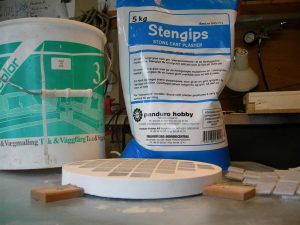Rough grinding have been a little complicated. I was recomended to increase the weight and used a heavy stone up on the mirror durring the rough grinding. And then it went fast and easy – a little to much fast and easy. I hollowed out 4 mm. and it is 1.1 mm. to much. The order of tool and mirror was changed, the mirror down and the tool up. And the sagitta went 3.3 mm. which is acceptable.
 A new tool is constructed by stone cast plaster and tiles. The tool is a little konvex as shown in the picture.
A new tool is constructed by stone cast plaster and tiles. The tool is a little konvex as shown in the picture.
But the konvex shape was not very smart. I couldn’t control the grinding and the mirror went hollowed out again. A new and plane tool was constructed and then I was able to control the grinding proces. Now the mirror have the right shape and a sagitta at 3.2 mm. which is 0.3 mm to much, but it is acceptable and grinding is continued with next kind of abrasive.
The purpose of the grinding proces is not to hollowing out anymore. The shape is approximately as it have to be and I’m ussing silicon carbide 80, silicon carbide 120, silicon carbide 220 and silicon carbide 220. For every shift of abrasive, the tool, mirror and workbench is cleaned carefully.
The grinding strokes used now is a W-stroke , it is a to-and-from-movement like a W. See this movie-clip (the strokes is to long, I make a new movie next time I grind a mirror):
Movie grovslib
The grinding proces is splitted up in trhee steps:
- Rough grinding with iron-tool, the mirror just have to be hollowed out.
- Using strokes-on-the-edge and carbo60 and coabo80. Sagitta have to be +- 10%. Time spending on grinding: 6 hours.
- Fine grinding with a tool constructed by glass-tiles or ceramic-tiles.
The aim is to make small corrections at the shape of the mirror otherwise the surface have to be smooth. Using W-strokes and carbo120, carbo220, carbo320, emery 125E and emery 50E. Fine grinding finished when foucaulttest is OK. Spending 6 hours on fine grinding.
Polishing with pitch-tool, which will be described in details later. Using w-strokes like in fine grinding and cerium oxide. Spending about 3 hours.
The abrasive is shifted when the surface is uniform from edge to edge.
